The Application of Commercial Surface Acoustic Wave Radio Communication Filters as Transducers for DMMP Sensors
Abstract
:1. Introduction
2. Materials and Methods
2.1. Materials and Instrumentation
2.2. Stand for Testing SAW Sensors
3. Results and Discussion
3.1. Manufacture of Chemical Sensor
3.2. Measurements with DMMP Vapor
4. Conclusions
Supplementary Materials
Author Contributions
Funding
Institutional Review Board Statement
Informed Consent Statement
Data Availability Statement
Conflicts of Interest
References
- Auld, B.A.; Green, R.E. Acoustic Fields and Waves in Solids: Two Volumes. Phys. Today 1974, 27, 63–64. [Google Scholar] [CrossRef]
- Tiersten, H.F.; Sinha, B.K. A Perturbation Analysis of the Attenuation and Dispersion of Surface Waves. J. Appl. Phys. 1978, 49, 87–95. [Google Scholar] [CrossRef]
- Martin, S.J.; Frye, G.C.; Senturia, S.D. Dynamics and Response of Polymer-Coated Surface Acoustic Wave Devices: Effect of Viscoelastic Properties and Film Resonance. Anal. Chem. 1994, 66, 2201–2219. [Google Scholar] [CrossRef]
- Ballantine, D., Jr.; White, R.; Martin, S.; Ricco, A.; Frye, G.; Zellers, E.; Wohltjen, H. Acoustic Wave Sensors: Theory, Design, and Physico-Chemical Applications in Applications of Modern Acoustics; Academic Press: Cambridge, MA, USA, 1996. [Google Scholar]
- Panneerselvam, G.; Thirumal, V.; Pandya, H.M. Review of Surface Acoustic Wave Sensors for the Detection and Identification of Toxic Environmental Gases/Vapours. Arch. Acoust. 2018, 43, 357. [Google Scholar] [CrossRef]
- Singh, H.; Raj, V.B.; Kumar, J.; Durani, F.; Mishra, M.; Nimal, A.T.; Sharma, M.U. SAW Mono Sensor for Identification of Harmful Vapors Using PCA and ANN. Process Saf. Environ. Prot. 2016, 102, 577–588. [Google Scholar] [CrossRef]
- Han, J.; Li, M.; Li, H.; Li, C.; Li, H.; Qian, L.; Yang, B. A 433-MHz Surface Acoustic Wave Sensor with Ni-TiO2-Poly(L-Lysine) Composite Film for Dopamine Determination. Mikrochim. Acta 2020, 187, 671. [Google Scholar] [CrossRef] [PubMed]
- Guo, X.; Zhang, J.; Chen, Y.; He, Y.; Wang, L.; Zheng, Y. Ultrasensitive Surface Acoustic Wave Gas Sensor for Trace VOCs Detection Based on Sensing Mechanism of Gas-Liquid Phase Transition. In Proceedings of the 2021 21st International Conference on Solid-State Sensors, Actuators and Microsystems (Transducers), Orlando, FL, USA, 20–24 June 2021; pp. 1227–1230. [Google Scholar] [CrossRef]
- Soluch, W. Application of Synchronous Two-Port Resonators for Measurement of SAW Parameters in Piezoelectric Crystals. IEEE Trans. Ultrason. Ferroelectr. Freq. Control 1998, 45, 1113–1116. [Google Scholar] [CrossRef] [PubMed]
- Soluch, W. SAW Synchronous Multimode Resonator with Gold Electrodes on Quartz. IEEE Trans. Ultrason. Ferroelectr. Freq. Control 2008, 55, 1391–1393. [Google Scholar] [CrossRef] [PubMed]
- Abdal-Kadhim, A.; Kok, S.L. An Investigation of the Power Consumption of 315 MHz RF Ask Transmitter and Receiver Modules for Wireless Sensor Network Node. J. Eng. Sci. Technol. 2018, 13, 473–488. [Google Scholar]
- Moise, M.V.; Niculescu, A.M.; Pavel, D.M.; Oţoiu, M. IoT Environmental Monitoring and Control System in a Research Centre. In Proceedings of the 2022 45th International Spring Seminar on Electronics Technology (ISSE), Vienna, Austria, 11–15 May 2022; pp. 1–4. [Google Scholar] [CrossRef]
- Frankiewicz, M.; Jabłeka, M.; Boroń, K.; Urban, P.; Guździk, J.; Ryszko, A.; Jiang, G. Method for 315/433 MHz Remote Keyless Entry Sensitivity and Range Statistical Analysis for Automotive Applications. In Proceedings of the 2015 22nd International Conference Mixed Design of Integrated Circuits & Systems (MIXDES), Torun, Poland, 25–27 June 2015; pp. 481–485. [Google Scholar] [CrossRef]
- Ricco, A.J.; Martin, S.J. Multiple-Frequency SAW Devices for Chemical Sensing and Materials Characterization. Sens. Actuators B Chem. 1993, 10, 123–131. [Google Scholar] [CrossRef]
- Pedrick, M.K.; Tittmann, B.R. Sensitivity Comparisons of Layered Rayleigh Wave and Love Wave Acoustic Devices. In Health Monitoring of Structural and Biological Systems 2007, Proceedings of the SPIE, San Diego, CA, USA, 19–22 March 2007; SPIE: Bellingham, WA, USA, 2007; Volume 6532, pp. 215–226. [Google Scholar] [CrossRef]
- Pasternak, M. Applicability of Different SAW Oscillators’ Topologies for High Frequency Gas Sensors Construction. Acta Phys. Pol. A 2010, 118, 1232–1234. [Google Scholar] [CrossRef]
- Hardware Manual for miniVNA Tiny. Available online: https://www.wimo.com/media/akeneo_connector/media_files/M/i/MiniVNA_Tiny_hardware_manual_en_d633.pdf (accessed on 29 May 2024).
- R315 F11 Specification. Available online: www.yangxing.hk/u_file/photo/20211020/R315%20F11.pdf (accessed on 19 June 2024).
- R433 F11 Specification. Available online: www.yangxing.hk/u_file/photo/20211020/R433A-F11-D11.pdf (accessed on 19 June 2024).
- Long, G.L.; Winefordner, J.D. Limit of Detection a Closer Look at The IUPAC Definition. Anal. Chem. 1983, 55, 712A–724A. [Google Scholar]
- Grate, J.W. Hydrogen-Bond Acidic Polymers for Chemical Vapor Sensing. Chem. Rev. 2008, 108, 726–745. [Google Scholar] [CrossRef] [PubMed]
- Grabka, M.; Jasek, K.; Witkiewicz, Z. Hydrogen-Bond Acidic Materials in Acoustic Wave Sensors for Nerve Chemical Warfare Agents’ Detection. Sensors 2024, 24, 2477. [Google Scholar] [CrossRef] [PubMed]
- Grabka, M.; Witkiewicz, Z.; Jasek, K.; Piwowarski, K. Acoustic Wave Sensors for Detection of Blister Chemical Warfare Agents and Their Simulants. Sensors 2022, 22, 5607. [Google Scholar] [CrossRef] [PubMed]
- Grate, J.W.; Rose-Pehrsson, S.L.; Venezky, D.L.; Klusty, M.; Wohltjen, H. Smart Sensor System for Trace Organophosphorus and Organosulfur Vapor Detection Employing a Temperature-Controlled Array of Surface Acoustic Wave Sensors, Automat-ed Sample Preconcentration, and Pattern Recognition Available. Anal. Chem. 1993, 65, 1868–1881. [Google Scholar] [CrossRef]
- Grabka, M.; Jasek, K.; Pasternak, M. Application of Polymethyl [4-(2,3-Difluoro-4-Hydroxyphenoxy)Butyl] Siloxane in Surface Acoustic Wave Gas Sensors for Dimethyl Methylphosphonate Detection. Sens. Actuators B Chem. 2021, 329, 129216. [Google Scholar] [CrossRef]
- Wang, W.; Hu, H.; Chen, G.; Xie, X.; He, S. Optimization of a BSP3-Coated Surface Acoustic Wave Chemical Sensor. IEEE Sens. J. 2015, 15, 6730–6737. [Google Scholar] [CrossRef]
- Piqué, A.; Auyeung, R.C.Y.; Stepnowski, J.L.; Weir, D.W.; Arnold, C.B.; McGill, R.A.; Chrisey, D.B. Laser Processing of Polymer Thin Films for Chemical Sensor Applications. Surf. Coat. Technol. 2003, 163–164, 293–299. [Google Scholar] [CrossRef]
- Wang, Y.; Du, X.; Li, Y.; Long, Y.; Qiu, D.; Tai, H.; Tang, X.; Jiang, Y. A Simple Route to Functionalize Siloxane Polymers for DMMP Sensing. J. Appl. Polym. Sci. 2013, 130, 4516–4520. [Google Scholar] [CrossRef]
- Wang, Y.; Du, X.; Long, Y.; Tang, X.; Tai, H.; Jiang, Y. The Response Comparison of a Hydrogen-Bond Acidic Polymer to Sarin, Soman and Dimethyl Methyl Phosphonate Based on a Surface Acoustic Wave Sensor. Anal. Methods 2014, 6, 1951–1955. [Google Scholar] [CrossRef]
- Du, X.; Ying, Z.; Jiang, Y.; Liu, Z.; Yang, T.; Xie, G. Synthesis and Evaluation of a New Polysiloxane as SAW Sensor Coatings for DMMP Detection. Sens. Actuators B Chem. 2008, 134, 409–413. [Google Scholar] [CrossRef]
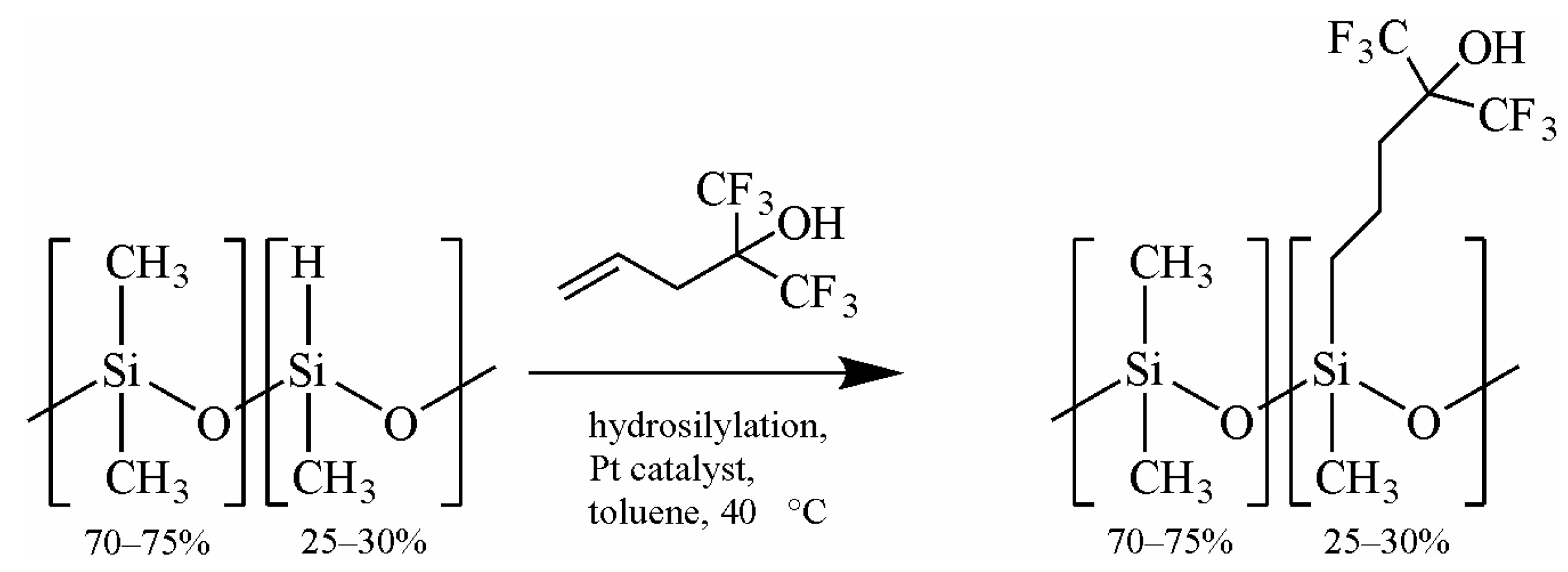
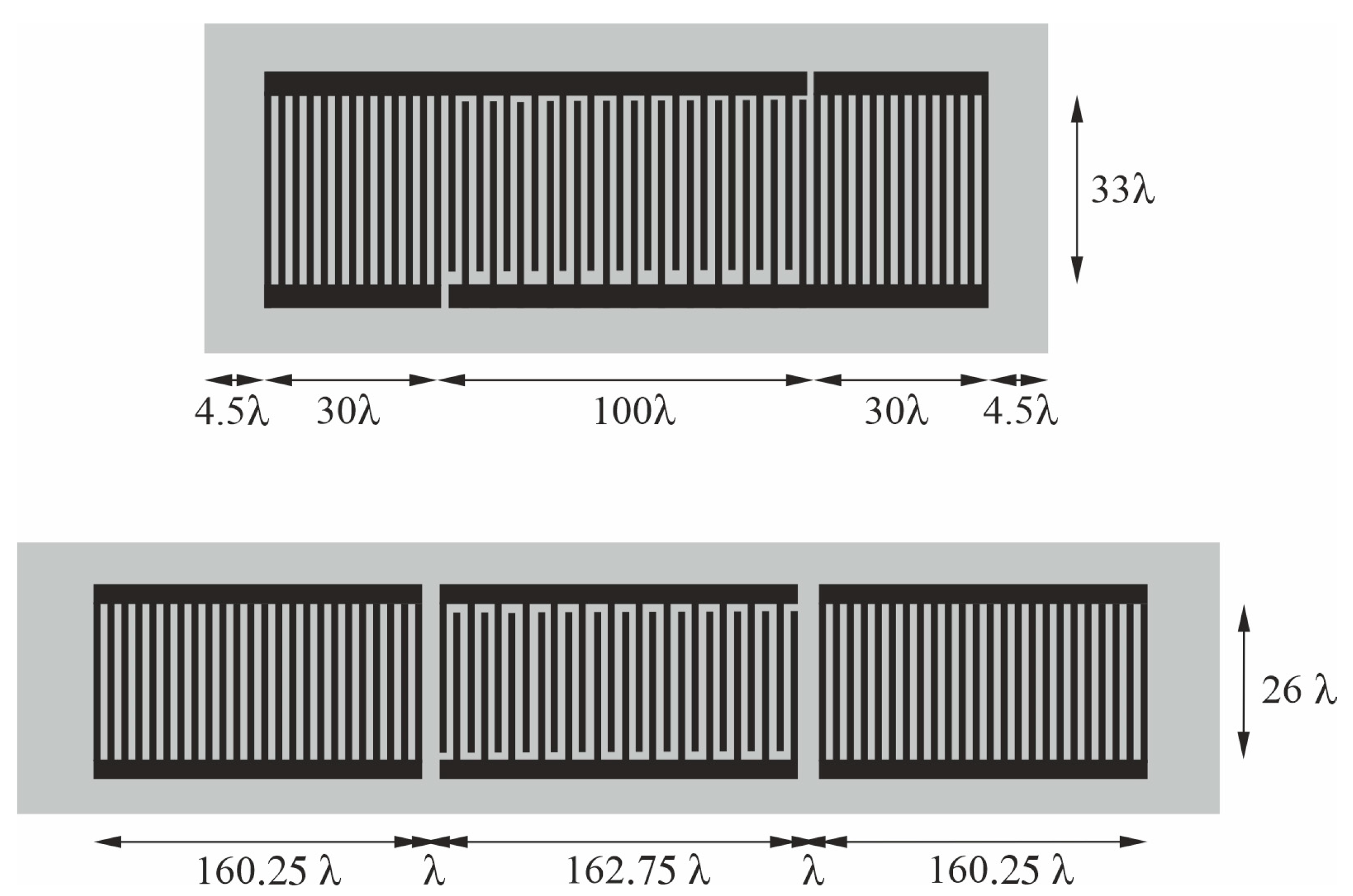
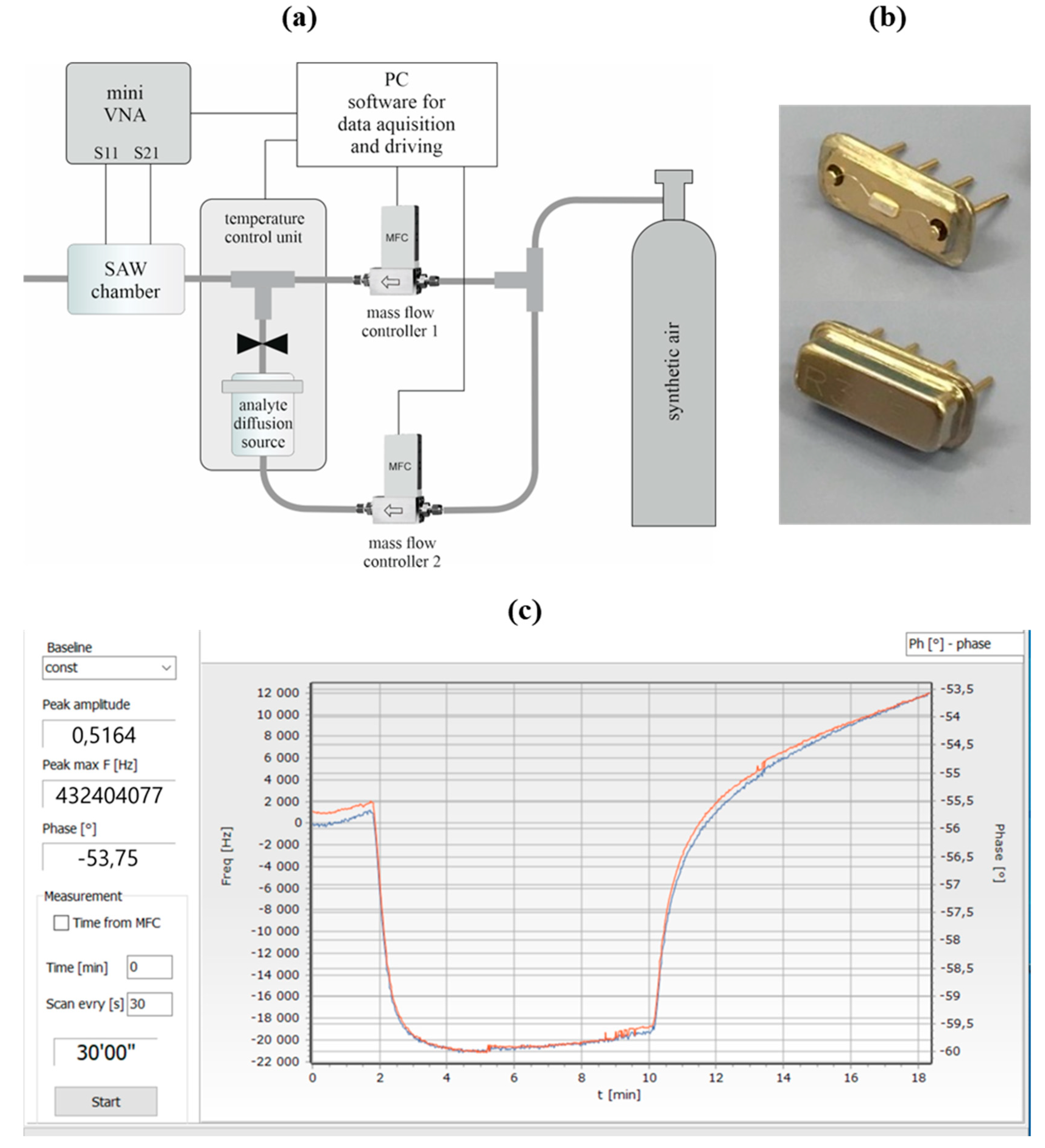
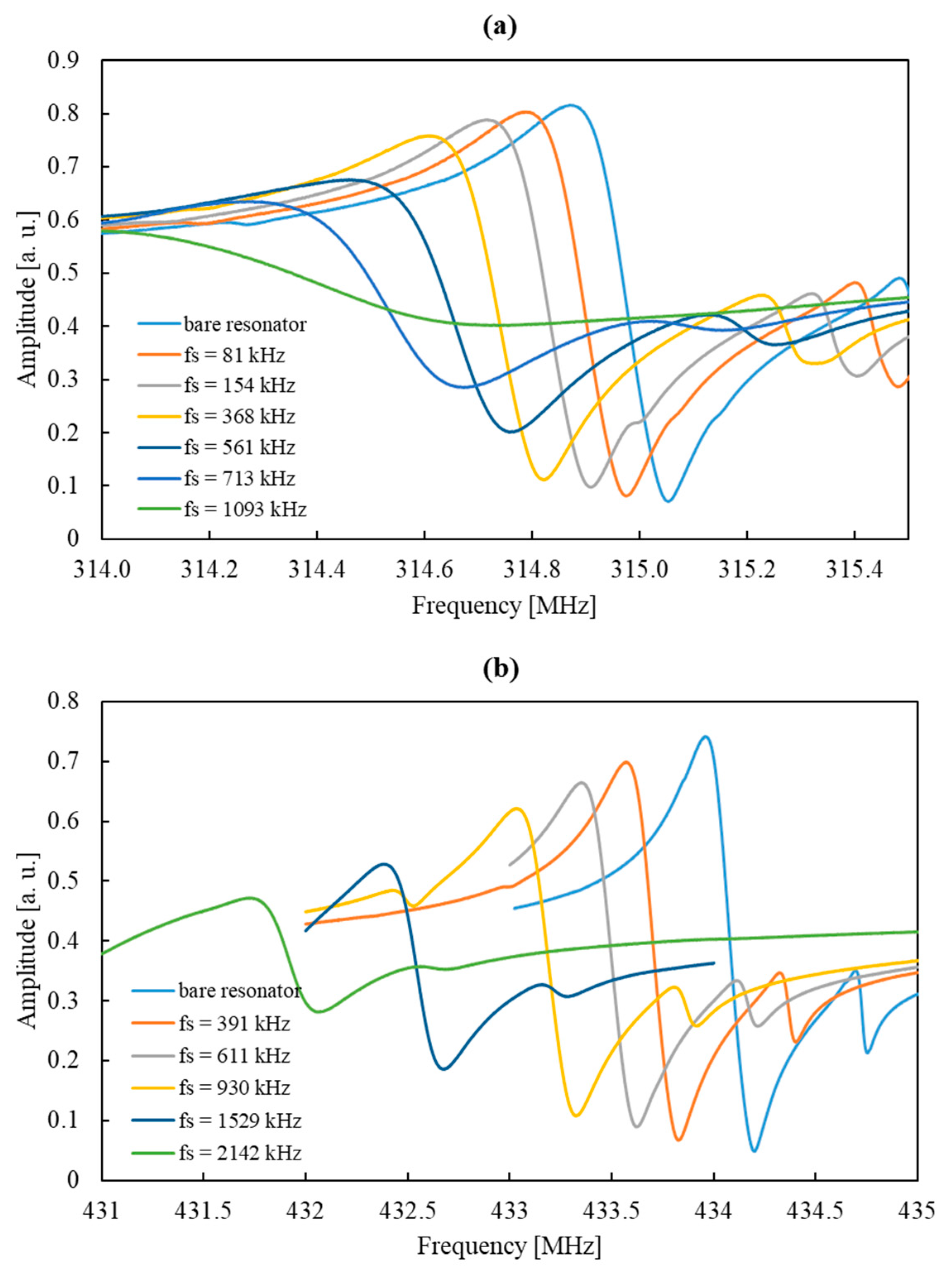
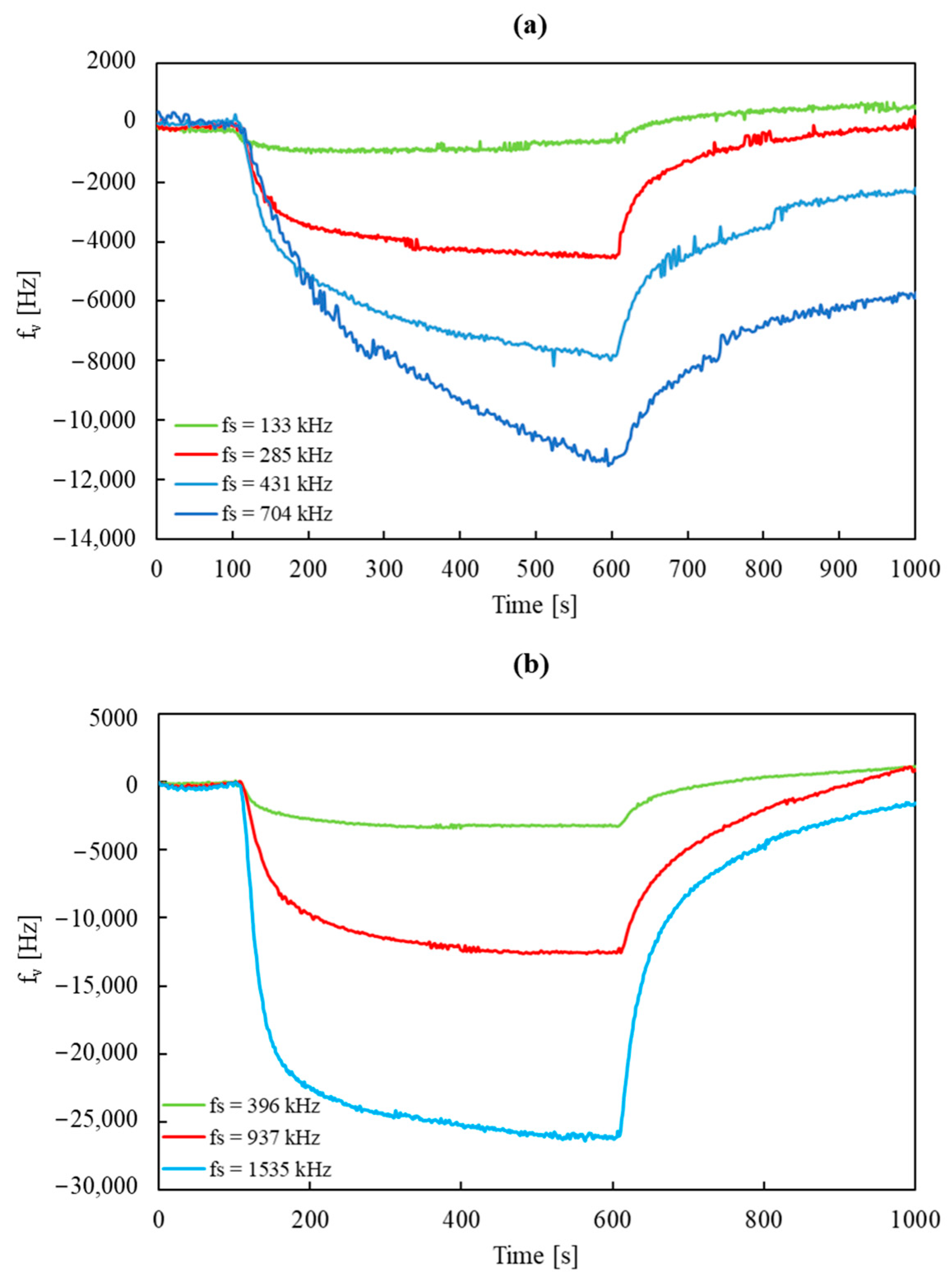
| Type of Resonator | Unloaded Q Factor | 50 Ω Loaded Q Factor | Insertion Loss [dB] | Temperature Stability [ppm/°C] | Static Capacitance [pF] |
|---|---|---|---|---|---|
| 315 MHz | 12,800 | 2000 | 1.5 | 0.037 | 2.7 |
| 433 MHz | 12,000 | 1500 | 1.6 | 0.032 | 2.3 |
| SAW Device | fs [kHz] | σ [kHz] | fv [kHz] | σ/fv·103 |
|---|---|---|---|---|
| R315 | 133 | 0.05 | 1.01 | 50.48 |
| 285 | 0.07 | 3.85 | 18.08 | |
| 431 | 0.06 | 6.43 | 8.99 | |
| 704 | 0.15 | 7.94 | 18.69 | |
| R433 | 396 | 0.05 | 3.20 | 15.28 |
| 937 | 0.10 | 13.28 | 7.48 | |
| 1535 | 0.15 | 23.43 | 6.21 | |
| 2142 * | - | - | - |
| Type of SAW Device/Center Freq. [MHz] | fs [kHz] | Temperature [°C] | DMMP Conc. [mg/m3] | Response [kHz] | Source |
|---|---|---|---|---|---|
| Delay line/158 | 250 | 30 | 1.1 | 1.3 | [24] |
| Two-port resonator/195 | 100 | 30 | 1.5 | 0.62 | [25] |
| Two-port resonator/300 | 170 | 20 | 1.5 | 4.0 | [26] |
| Two-port resonator/195 | 100 | 30 | 1.5 | 0.5 | [25] |
| Two-port resonator/417 | 500 | Not available | 0.1 | 2.2 | [27] |
| Two-port resonator/433 | 770 | 15 | 1 | 3.2 | [28] |
| Two-port resonator/433 | 740 | 15 | 1 | 10 | [28] |
| Two-port resonator/433 | 1200 | 20 | 1 | 11 | [29] |
| One-port SAW resonators/433 | 200 | 30 | 5.5 | 4.3 | [6] |
| One-port resonator/433 | 600 | 25 | 28 | 35 | [30] |
| One-port SAW resonators/315 | 700 | 25 | 3 | 7.9 | This work |
| One-port SAW resonators/433 | 1500 | 25 | 3 | 23 | This work |
Disclaimer/Publisher’s Note: The statements, opinions and data contained in all publications are solely those of the individual author(s) and contributor(s) and not of MDPI and/or the editor(s). MDPI and/or the editor(s) disclaim responsibility for any injury to people or property resulting from any ideas, methods, instructions or products referred to in the content. |
© 2024 by the authors. Licensee MDPI, Basel, Switzerland. This article is an open access article distributed under the terms and conditions of the Creative Commons Attribution (CC BY) license (https://creativecommons.org/licenses/by/4.0/).
Share and Cite
Grabka, M.; Jasek, K.; Pasternak, M.; Witkiewicz, Z. The Application of Commercial Surface Acoustic Wave Radio Communication Filters as Transducers for DMMP Sensors. Sensors 2024, 24, 4299. https://doi.org/10.3390/s24134299
Grabka M, Jasek K, Pasternak M, Witkiewicz Z. The Application of Commercial Surface Acoustic Wave Radio Communication Filters as Transducers for DMMP Sensors. Sensors. 2024; 24(13):4299. https://doi.org/10.3390/s24134299
Chicago/Turabian StyleGrabka, Michał, Krzysztof Jasek, Mateusz Pasternak, and Zygfryd Witkiewicz. 2024. "The Application of Commercial Surface Acoustic Wave Radio Communication Filters as Transducers for DMMP Sensors" Sensors 24, no. 13: 4299. https://doi.org/10.3390/s24134299





